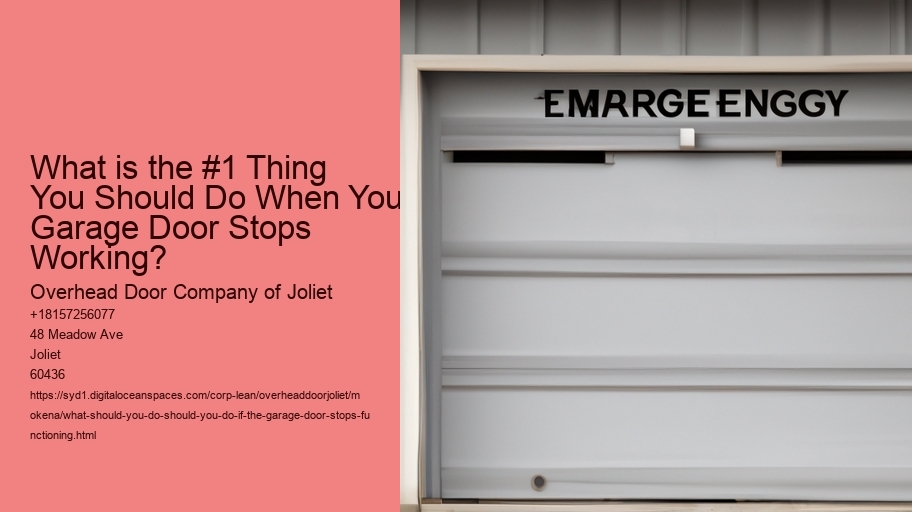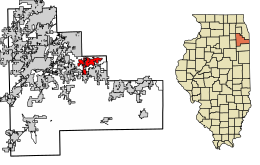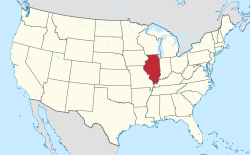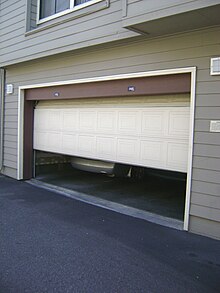What kind of garage door Opener and Door Do You Have? What is the One Thing You Need to Do When Your Garage Door Stops Working? .
When garage doors suddenly stop working, it can be a stressful and uncomfortable experience.Whether you're rushing to work, or trying to move your car into the garage during a rainstorm an unresponsive door is not something you would want to deal with.The initial step to tackle the issue is to determine the type of opener and garage door that you have as it will greatly affect the way you approach fixing and troubleshooting.
Roll-up garage doors, often used in commercial environments constructed from Slats that are folded into coils.
Tilt-up doors, on other hand are made of a single piece that can be tilted out and upwards when it opens.Equally important is identifying the type of garage door opener.The three primary types are belt-drive, chain drive, and screw-drive openers.Chain-drive openers, which use an iron chain to raise and lower the door, are long-lasting and affordable but they are noisy.Belt-drive openers operate similarly but use a rubber belt which makes them quieter and a great choice for attached garages.Screw-drive openers open and close the door by means of a threaded steel rod and offer a good balance of sound and cost.
Once you've identified your garage door and opener type The next step is to carry out an initial check for typical issues.Ensure that there is power to the opener by examining the outlet as well as the breaker.Inspect the manual release cord to make sure that it isn't pulled, which will disconnect the door from the opener.Examine the door's tracks and rollers for obstructions, or damage and clear any obstructions.
If necessary, lubricate the moving components. Insufficient lubrication could cause them to become stuck or even become stuck.Resetting your opener is a solution to any electronic malfunctions. Check the manual for the opener you're using to find out the specific instructions. Certain openers can be reset with a push of the button, whereas others require that the unit not be plugged in and after that, it must be re-plugged.
The tension on springs can be high, and it can be hazardous to repair them without the proper tools.
When the garage door stops working you'll be able to tell the
Look for any obstructions or debris.
If the garage door abruptly ceases working, it can be extremely frustrating and confusing, especially if it's a element of your daily routine.
One of the most important and most effective steps to do when confronted in this scenario is to examine the door for any obstructions or debris.This simple, yet powerful action can often be the key to pinpointing the issue and restoring the functionality of the garage door.Garage doors are based through a system consisting of rollers, tracks and other moving parts that need to be free of hindrances to function smoothly.Over time, dirt, leaves, small rocks, or other debris can build up along the tracks, or get stuck in the rollers.Even small obstacles can prevent the door from closing or opening properly.Therefore, a thorough inspection of these parts is the first thing you do.
Begin by examining the tracks on both sides of the door.Look for any obvious obstructions or the accumulation of debris.If you notice anything unusual, such as the twig or the stone stuck in the track, be sure to remove it.
There are times when the problem might not be obvious So, it's recommended to stretch your hand along the track to feel for any unnoticed obstacles.Ensure that the tracks are aligned correctly as well, as any misalignment could result in the door becoming jammed.In the next step, examine the rollers and hinges.These parts should be able to move without resistance.If they're sticky or stuck, it might be an indication of accumulated dirt or rust.In situations like this, cleaning and lubricating them can often resolve the issue.Use a soft cloth or brush to wash away any dust, and then apply a lubricant that is suitable to ensure smooth movement.
It's also important to check the area surrounding the door itself.Sometimes things stored in the garage can accidentally move or fall, blocking the route of the door.Ensure that the space is clean and that there is nothing blocking the door's movement.
Check the sensors if the door does not open after you have removed any obstructions.
The sensors in modern garage doors may fail when they're dirty, or if they are not aligned correctly.In conclusion, when confronted with a garage door that suddenly isn't functioning, checking for obstructions or other debris is a logical and often useful first step.It requires minimal tools and knowledge, but it could save your time, money, as well as the inconvenience of contacting a professional for what could be a straightforward fix.By keeping a clear path and
Examine the Remote Control and Wall Switch
It is important to verify the wall switch as well as the remote control.
Checking these components can help you save time and prevent costly mistakes.First, consider the remote control.This handheld device is your primary tool for operating the garage door without direct physical interaction.Over time, remote controls can experience issues such as drained batteries, signal interference, or even internal damage.Start by replacing the batteries with new ones.It might seem simple, but dead batteries are a common reason for a garage door not responding.If the problem persists after replacing the batteries, try reprogramming the remote according to the manufacturer's instructions.Additionally, ensure that the remote is within the recommended range and that there are no obstructions blocking the signal.
Then, pay attention towards the wall switch. It is a crucial component of the garage door's system.
The wall switch is linked to the garage door opener and typically provides a more reliable way of operation.Inspect the switch for signs of physical damage, or wear.Sometimes, loose wires or connections that aren't working properly can cause the switch to malfunction.If you feel comfortable doing this, access the switch's control panel and look for damaged or disconnected wires.If you discover any issues the need to consult an expert electrician to resolve the issue.The wall switch or the remote control may be working properly however the door still not working. This could indicate problems with the garage opener unit, or with other components like sensors or door tracks.
It is possible to eliminate these issues before moving on to more intricate troubleshooting. To conclude, checking the wall switch and the remote control whenever your garage door stops working is a straightforward and efficient approach.By addressing these components first, you will be able to quickly determine if the issue lies within these components or if additional investigation is needed.This initial examination not only saves time but also gives you security knowing that you've taken the appropriate steps to identify the problem correctly.
What should you do should you do if the garage door stops functioning? - President of the United States
- Ohio
- census
- fiber
Check the door's balance manually
When the garage door stops working and then it stops working, it can be difficult as well as inconvenient.The garage door is an a vital part of your house, offering security, shielding from the elements, and easy access to your car and storage space.
Manually testing the balance of the garage door can be a critical step to take in the event that your door is not functioning properly. This simple but powerful technique will allow you to identify any issues that might be present and also prevent any further damage.Balance in a garage door is crucial to its optimal operation. An imbalanced door can create more serious issues, including misalignment and broken springs.
To test the door's balance, you must first disconnect the garage door opener.
Many garage doors have the release mechanism, which is usually the handle or red cord that allows you to disengage the door from the motor.Once the door has been disconnected then carefully raise it to about waist height, and then release it.A properly balanced door should remain in place or move very slowly.If the door is falling rapidly or shoots upwards it is a sign of an imbalance.What should you do should you do if the garage door stops functioning? - Springfield
- belt
- Central Illinois
- Chicago metropolitan area
It is recommended that you contact a professional to help you adjust the springs so that the garage door is balanced. This will not only solve the problem but will also extend the life and efficiency of your garage door.
Checking the balance manually of your garage door is a crucial first step to make if it suddenly stops functioning.
By addressing issues quickly and understanding the importance in addressing the issue, you can make sure that your garage door will operate seamlessly and safely in future.Tracks and Rollers
This quick check can make it easier to save time and money when your garage door is not functioning.
The tracks and rollers in the garage's operation system are crucial. The tracks comprise metal rails that help guide the door when it opens. The rollers are the ones that move through the tracks.
These parts are prone to be worn out, dirty or misaligned as time passes. This could cause operational problems.Begin by examining the track for any obstructions. Grime, dirt and even small particles could be accumulating, which causes rollers to struggle to move along the path. Cleaning the tracks with an aqueous cloth will resolve the issue.
After that, you should check the alignment of the tracks.Tracks must be straight and parallel to other.If they appear bent or out of alignment, the door could jam.You can gently tap the misaligned sections back into their proper position with a rubber mallet.However when the damage is significant and extensive, you should seek out a professional for help to align the tracks properly in order to ensure safety and function.
Checking the rollers is equally important.Over time, the rollers may wear out or become damaged, especially if they are constructed from plastic.
Look for indications of wear and tear like cracks or chips.If the rollers seem worn, consider changing them out with brand new ones.Metal rollers with ball bearings are more likely to provide more durability and smoother operation.In addition, lubrication plays an vital role in maintaining the seamless movement of tracks and rollers.Applying the lubricant with a silicone base can decrease friction and reduce wear.Make sure that you lubricate all moving parts, including springs and hinges to make sure that your garage door is operating efficiently.
To conclude, taking a look at the rollers and tracks is a practical first step if the garage door suddenly isn't working.It's an easy process that will often reveal and fix frequent issues.By making sure that these parts are clean, aligned, and well-lubricated you can often bring your garage door back to full functionality without having to make costly repairs.
Regularly inspecting and maintaining these parts will also assist in preventing any future malfunctions. This will help prolong the life of your garage system.Check for visible damage or wear
When a garage door suddenly stops working, it can be very frustrating and aggravating particularly when you are going out or attempting to protect your home from the evening.While there could be many reasons for the malfunction, one of the most effective and quick options is to look for visible damage or wear.This initial inspection can often identify the source of the issue, allowing the door to be repaired quickly and efficiently. solution.
Garage doors are an intricate system composed of numerous parts, such as springs, cables as well as rollers and tracks every one of which plays a crucial role in the smooth operation.Over time, these parts can experience wear and tear from regular use and exposure to environmental elements.
If you conduct a thorough visual examination, you will be able to identify any obvious indications of damage cause for the door to fail.Begin by checking the springs that are essential in the lifting and lower of the door.Look for signs of corrosion, damage, or misalignment.A damaged or worn spring could make the door inoperable, and it is crucial to fix the issue promptly.Next, move on to the cables and look for fraying or broken wires that might hinder the door's movement.Similarly check the rollers and tracks for any damage, dents, or obstructions that may be obstructing the path of the door.
The door is yet another part that needs focus. Be aware of visible cracks, warpings, or bends.
In addition, ensure that the sensors of the door are clear and aligned, because misalignment or dirt could interfere with their functions and result in the door not functioning.A visual inspection is valuable however it's essential to be aware that not every issue is immediately apparent. If you don't see any obvious indications of wear or damage you might need to speak with a specialist to pinpoint the problem.
When faced with an unusable garage door, checking for visible damage or wear is the initial step.This technique not only aids in identifying the issue quickly but also empowers you to decide the best course of action to restore the door to its proper functioning.
By being proactive and attentive by being proactive and attentive, you can ensure the longevity and reliability of your garage doorVerify for Springs and Cables
If your garage door suddenly stops functioning is both painful as well as inconvenient.One of the most important steps you need to take in this instance is to assess the springs as well as cables.These components are vital to the operation of your garage door and issues related to them are typically the culprits behind a malfunctioning door.
The springs play a crucial part in the functioning and smoothness of your garage by supporting the weight. There are two main spring types, extension and torsion. Torsion springs are placed above the garage and then twist to store energy. Extension springs are on the other hand are installed between the doors and extend to create the force needed.
What should you do should you do if the garage door stops functioning? - President of the United States
- President of the United States
- Springfield
- Carbondale
The cables can also be damaged through wear and tear. They could fray or snap when pressure is applied.
When assessing the springs and cables, begin by visually looking at them.Look for indications of wear, rust or fraying.If you spot a broken spring or cable it is essential to stay clear of using the door until the problem is resolved, as forcing it can cause more injury or result in an accident.If the springs seem to be in good condition however the door is not functioning, it could be that they have lost tension and need adjustment.
It's vital to focus on security when working with garage door parts.
The cables and springs are under tension and could result in serious injuries. If you don't have any experience with garage door repair, it is best to call an expert. They will possess the tools and knowledge needed to safely repair or replace these parts. This ensures the garage door works in a safe and efficient manner.In conclusion, when your garage door suddenly stops working, assessing the springs and cables is a key step in diagnosing the problem.Understanding their role and potential issues can help you determine whether a simple adjustment is needed or if professional intervention is required.Taking prompt action not only restores functionality but also ensures the safety and longevity of your garage door system.
You Need to Call a Professional Technician
The garage door could suddenly stop working, causing you to lose your time. It could make your home vulnerable.
Although it may be tempting to grab your toolbox and attempt an at-home fix The most sensible option is to call an experienced technician.This option not only assures your safety but also offers a more effective and lasting solution to the problem.Garage doors are complex systems composed of various components such as springs, cables, tracks, and electronic parts.Each of these elements plays a crucial role in the door's operation, and a malfunction in any part can cause the entire system to fail.Without proper knowledge and experience, attempting to fix these issues can be dangerous.For instance, garage door springs are under high tension and can cause severe injury if handled improperly.Professional technicians are trained to deal with these risks safely, using the right tools and techniques to handle repairs.
Additionally, a professional technician has experience and expertise that a layperson simply does not possess.
They can quickly diagnose the issue and identify whether it's a minor problem, like a misaligned track, or something more serious, like a broken spring.This expertise not only saves you time but also prevents the potential for further damage that can occur with incorrect handling.Professionals also have access to high-quality parts and can ensure that replacements match the specifications of your existing garage door system, leading to better functionality and longevity.A professional technician can also save money in the long-term. While DIY methods DIY method may appear to be less costly initially but it could result in more costly and extensive repairs later.
Many technicians also provide guarantees on their work, which provides peace of mind knowing that if something goes wrong, you're covered.In the end, contacting a expert can save you considerable time and hassle.Trying to understand the complexities of garage door mechanics, purchase the proper tools, and execute the repair could take hours or even days.In the opposite, a professional can often resolve the issue in a short time, allowing you to get back to your routine without delay.
In the end, even though the desire to fix your garage door yourself might be powerful, contacting an expert technician is the safest effective, efficient, and ultimately, the best option.Their knowledge, expertise as well as access to top-quality parts, and the ability to complete quick and precise repairs will ensure that your garage door is back and running smoothly again and will protect your home and your valuables.


















